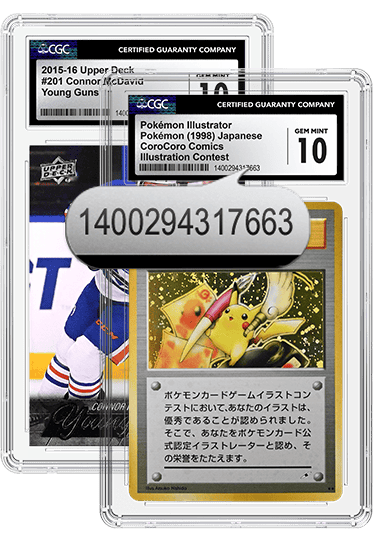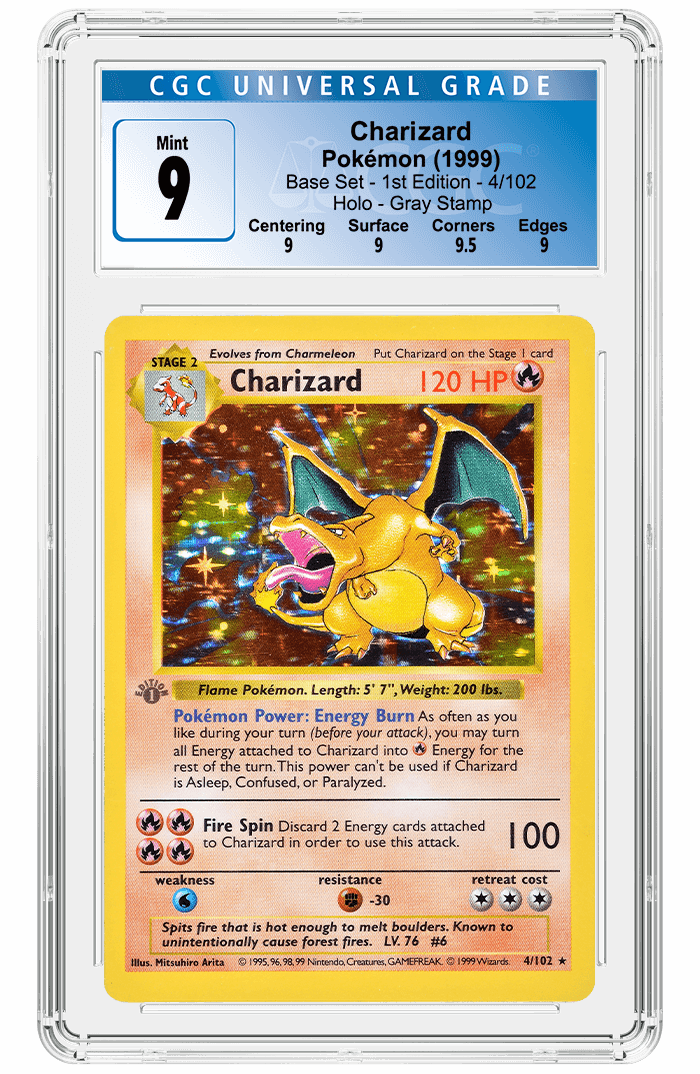CGC Trading Cards Certifies Extremely Rare Base Set Charizard Test Print
Posted on 6/16/2022
By
Paul Sandler
Director of Product Development
CGC Trading Cards was thrilled to recently authenticate and grade an extremely rare Charizard test print card from the 1999 Base Set. The card is exceptionally interesting because it lacks many details — like an image of Charmeleon in the evolution box, the flavor text below the art box and the Energy symbols — that would typically be seen on the card. In addition, the card features a unique “Disco” holofoil pattern that has never been used on any regular production Pokémon cards. (The term “Disco” is CGC Trading Cards’ as there is no official description of this foil type.)
The card is square cut and likely was cut from an original sheet such as the one seen here. Test prints were generally not cut at the factory, and when they were, the cards often did not make it to the corner rounding process. As these are very esoteric items, CGC Trading Cards does not differentiate test prints as being either factory cut or not factory cut.
History of the card
Much of the information regarding these types of test prints is conjecture, but some assumptions can be made. For example, the sheet (linked above), which was sold by Hake’s Auctions in November 2021, features a hand-inscribed note of D. Davis 1-21, which almost certainly corresponds to the signoff of a pressman on that sheet on January 21, 1999. This was after the release of Base Set on January 9 of that same year. Therefore, this card was almost certainly not printed before the release of Base Set.
In addition, the sheet from the auction features the later layout of the Unlimited print run sheets as opposed to those of the first edition print run. This adds to the evidence that this was not a test print that proceeded the Base Set but was instead one that followed.
It’s impossible to know with certainty the purpose of these sheets, but perhaps WotC was testing a new holofoil pattern for use on the Unlimited run cards or even for the Fossil or Jungle sets. In fact, former WotC Lead Typesetter Chris Nitz recalls multiple foils being tested: “There were tests run on a variety of available foil stocks. This is likely one of them.”
Another possibility is related to the fact that some of the design elements are missing. This is akin to a paper money progressive proof, which could mean that the designers were tweaking some of the background elements for future print runs. This was a common occurrence according to Mr. Nitz: “I hate the fact that there are missing design elements. For example, the evolution graphics in the top left corner, and the text on the bar under the Pokémon art. But this is how tests were done.”
While the reason these cards were printed may never be known, with CGC Trading Cards’ expertise, the card’s authenticity is not a mystery.
Analysis of the card
While many fakes and proxies exist of Base Set Charizards, even with a cursory glance, this card just looks “right.” The back appears completely correct, as does the printing quality on both sides. The holo pattern is similar to many counterfeits of the era, which might make someone believe this is also one. However, a closer look with CGC Trading Cards’ advanced technology proves this card was printed in the same way as a regular Base Set Shadowless card.
 |
 |
| The test print (left) and a regular Shadowless Charizard (right) under infrared light. Click images to enlarge. |
|
In the two photos above, note the same way in which all of the inks react with the infrared light. Most notable is the text for “Pokémon Power: Energy Burn” as well as the rectangular box where the flavor text is on the regular card. Even all of the different color inks on the Charizard itself react in the same way to this light source.
 |
 |
| The test print (left) and a regular Shadowless Charizard (right) under UV light. Click images to enlarge. |
|
Again, under UV light, the two cards react in the same way. In both cases, the only UV-reactive areas are the white parts of the design in the flames and surrounding Charizard. This is another very positive sign as counterfeit cards typically utilize card stocks or inks that react in a different manner than those of a genuine card. The backs of the two cards also look incredibly similar under infrared light. Clearly, it is a genuine Pokémon back.
 |
 |
| The back of the test print (left) and a regular Shadowless Charizard (right) under infrared light. Click images to enlarge. |
|
After establishing that a test print card has the appearance of a genuine card under multiple light sources, CGC Trading Cards goes above and beyond to prove the authenticity of a card beyond a reasonable doubt. Using an X-ray fluorescence (XRF) spectrometer, multiple spots on each card were tested.
 |
| A graph of the chemical elements in the ink/cardstock of the test print (green) and regular card (red). Click image to enlarge. |
The above graph shows a scan of Charizard’s wing on each card. All of the chemical elements, most notably calcium, titanium, iron, copper and zinc, are there in very similar proportions. This proves that both the card stock and ink used in the production of a regular card are the same used in the production of the test print.
 |
| A graph of the chemical elements of the test print (green), a regular card (red) and a counterfeit card (pink). Click image to enlarge. |
The graph above shows an example of the types of differences between this test print, a genuine regular card and a fake card. The zinc levels in the fake are many times those of the test print and real card, and the test print and regular card have some zirconium, which is completely absent in the fake card.
While in the first graph the calcium levels were a bit higher for the test print, overall, the graphs tracked very closely together. This proves the card was printed by the same printer using the same cardstock and inks.
A conclusively genuine test print
After a thorough review of the test print card, including a comparison with a known genuine example of the same card, it can be conclusively determined that the test print card is indeed genuine. Its authenticity was determined not only by CGC Trading Cards’ experts, but also by utilizing respected consultants, specialized imaging techniques and XRF analysis.
Due to their rarity and value within the hobby, cards like this Charizard require many hours of research to authenticate and grade. CGC Trading Cards is glad to pull back the curtain and share the processes used to certify these interesting cards from the earliest days of the Pokémon TCG.
Stay Informed
Want news like this delivered to your inbox once a month? Subscribe to the free CGC eNewsletter today!
 TB20220614190333608.png)



